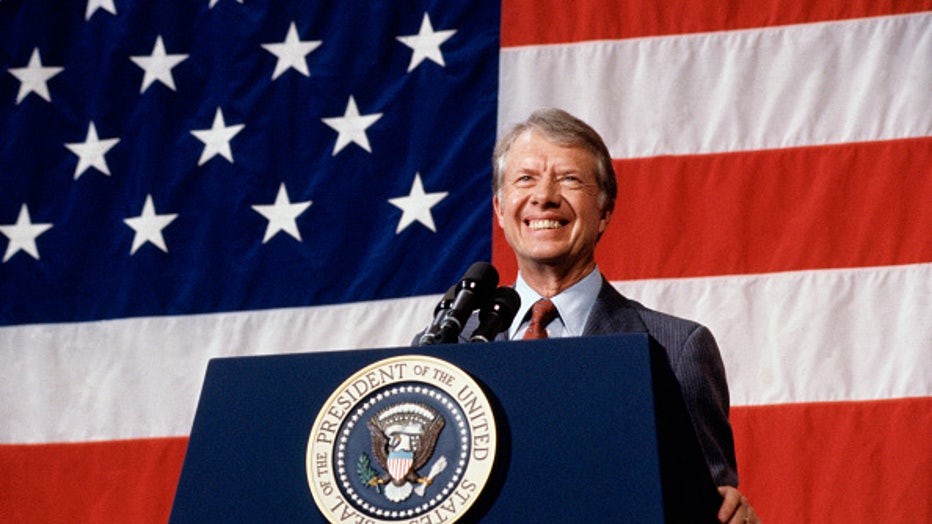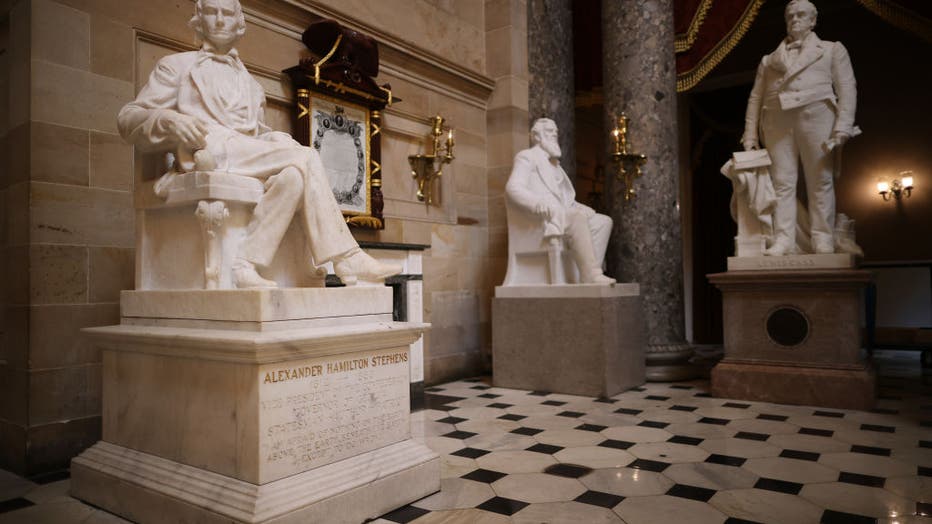Jimmy Carter statue proposed as alternate to Confederate leader at U.S. Capitol
Alexander Stephens and late President Jimmy Carter (Getty Images)
ATLANTA - A new resolution introduced in the Georgia Senate seeks to honor the late President Jimmy Carter by placing his statue in the National Statuary Hall of the U.S. Capitol. The proposal, led by State Sen. Jason Esteves, would create a committee to oversee the replacement of Alexander Hamilton Stephens’ statue, a monument that has been a source of controversy for decades.

(Original Caption) 3/24/1979-Elk City, Oklahoma: President Jimmy Carter addressing a town meeting. American flag is hung in background.
The argument for Carter over Stephens
What we know:
The proposed resolution calls for replacing Stephens' statue, which has represented Georgia in the U.S. Capitol since 1927. Stephens, former vice president of the Confederacy, was a staunch defender of slavery and openly rejected the Declaration of Independence’s claim that "all men are created equal." The push to remove his statue is part of a larger movement to rethink Confederate-era symbols in public spaces.
Sen. Esteves’ proposal argues that Carter is more deserving of the honor, citing his longstanding commitment to human rights, public service, and diplomacy. The resolution highlights Carter’s many achievements, including serving as a Georgia state senator, governor, and U.S. president, co-founding The Carter Center, winning the Nobel Peace Prize, and becoming the longest-living U.S. president at 100 years old.
RELATED: Georgia lawmakers push for Congressional Gold Medal to honor Jimmy Carter
If passed, the resolution would establish a committee to oversee the statue’s removal and Carter’s installation. Once Carter’s statue is in place, the committee would be disbanded.
Previous efforts to remove Stephens statue
The backstory:
The National Statuary Hall was established in 1864 under President Abraham Lincoln, allowing each state to select two statues for display in the Capitol. Many Southern states used this opportunity in the 1920s to honor Confederate leaders and segregationists. Georgia’s all-white General Assembly in 1926 first selected Dr. Crawford Long, a physician known for pioneering anesthesia, and the following year, lawmakers added Stephens.
The decision to honor Stephens was controversial from the start, and efforts to remove his statue have gained traction in recent years. In 2017, Stephens’ own descendants wrote an open letter to then-Gov. Nathan Deal, urging its removal so that "the descendants of enslaved people no longer walk beneath them at work and on campus." Additionally, Congressional Democrats, led by Nancy Pelosi (D-Calif.), also demanded the removal of Stephens' statue along with several others in 2017 and again in 2020.

WASHINGTON, DC - JUNE 18: A statue of Alexander Hamilton Stephens, vice president of the Confederate States from 1861 to 1865, is on display in Statuary Hall inside the U.S. Capitol June 18, 2020 in Washington, DC. Speaker of the House Nancy Pelosi (
What they're saying:
Supporters of the proposal argue that Carter’s legacy far outweighs that of Stephens and better represents Georgia’s contributions to history. The resolution itself describes Carter as a "distinguished Georgian" whose achievements make him "abundantly fitting and proper" for recognition in the U.S. Capitol.
There have been multiple proposals to replace Stephens' statue, including suggestions to honor Dr. Martin Luther King Jr., John Lewis, or another civil rights leader, according to Politico. Most recently, in 2024, a Georgia Republican suggested baseball legend Hank Aaron as a more suitable replacement, according to Atlanta Journal-Constitution.
Other states have already replaced divisive or racist figures in the Statuary Hall. Florida replaced a statue of a Confederate general with one honoring Black educator Mary McLeod Bethune and North Carolina replaced a statue of a white supremacist who served as governor with a statue of the Rev. Billy Graham.
Meanwhile, opponents of removing Confederate statues have historically argued that they are a part of history and should remain. However, the momentum has been shifting in recent years, with several Confederate monuments being removed across the country.
What's next:
If the resolution is approved, the committee will be tasked with overseeing the removal of Stephens' statue and the installation of Carter’s.
While Carter is the current favorite, previous discussions about replacing the statue with figures like Hank Aaron, John Lewis, or Dr. King suggest that there could still be debate over who should ultimately take Stephens’ place.
Regardless of the outcome, the push to remove the Confederate leader’s statue reflects a broader national conversation about how states choose to honor their historical figures—and who should represent them in the halls of government.

